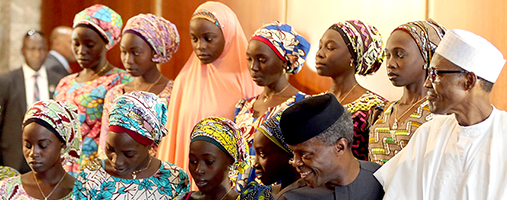Recently, the world viewed images of happy children and parents in Nigeria after Bokom Haram released 21 school girls from captivity. They were among the 276 girls abducted from a school in Borno State in 2014. The majority of the abductees are still missing.
The kidnappings received a lot of international attention, but these were not the only ones.
In the last few years, several thousand women and children have been abducted by the armed Islamist group, while some were forced to become sex slaves or suicide bombers. However, Boko Haram does not operate in all of Nigeria. They are active only in the northeastern part of the country, which is a relatively inaccessible border area. And this is one of the reasons why the group has gained a foothold, according to Andreas Forø Tollefsen, research fellow at the Department of Sociology and Human Geography.
- The area is located far from the capital, close to several international borders.
This increases the risk of conflict. In addition, the group has profited from weak local institutions by exploiting the resulting dissatisfaction among the inhabitants, he says.
In his doctorate Tollefsen has seen this pattern, namely that inaccessible areas experience more conflict. The same applies in areas where the quality of, and trust in, local institutions such as the police, judiciary and local politicians are low.
Time to change perspective
In 2015, there were 50 armed conflicts in the world, 49 of which were internal conflicts limited to one country. For a long time, peace researchers have directed most of their focus on how national conditions, such as governance, corruption and law enforcement, affect the level of conflict in a country. Such factors might have an impact on the level of stability or conflict, but according to Tollefsen’s thesis, local conditions are equally important.
Through a dataset developed by the Peace Research Institute (PRIO), Tollefsen has used information on a range of geographic data. This includes satellite data for forested areas, mountains, the general topography; geographical data showing infrastructure, for example roads, as well as data on ethnic groups. He has noticed that most of the conflicts are in inaccessible areas.
- This correlates with the difficulties the nation has in exercising control and with the fact that citizens in isolated areas feel unjustly treated because they have fewer privileges than other inhabitants.
Northeastern Nigeria is one such example. Similar cases are found in northern Mali, eastern Congo and northern Uganda.
In all of these places, local groups have taken control and challenged the regime’s monopoly on power. In the border areas in northern Uganda, the Lord's Resistance has terrorized inhabitants for years, only to pull back to secure zones in the jungle where they hide. In 2011, President Barack Obama sent 100 combat-ready soldiers to Uganda to help the government, but it resulted in the terrorist organization’s retreat into even more inaccessible areas.
Weak local institutions
Local institutions also contribute to making a region safe or unsafe, according to the thesis. To determine this, Tollefsen worked with Tore Wig to corroborate large surveys from 35 African countries with historical conflict data. In the surveys, people responded on how often they experienced corruption or how they rate the quality of local politicians.
The results show that well-functioning local institutions reduce the risk of conflict.
- Strong local institutions increases the state’s ability to exert its influence. This is important in order to resolve potential conflicts and reduce dissatisfaction in a region. Even if a region is inaccessible, strong institutions still allow the state to exert control, says Tollefsen.
And so the opposite is also true: With weak and ineffective local institutions, such as a corrupt police and judicial system that has little confidence among the people, there is an increased risk of conflict. This is one of many factors in northeastern Nigeria.
- Boko Haram is one of many groups that take advantage of weak local institutions.
They fill a power vacuum in a region where no one has strong control, according to Tollefsen. Poverty increases the risk of conflict, but if a region has solid institutions, the risk becomes much less, he says. He found no correlations between poverty and conflict in regions with strong local institutions.
Peace must start locally
There may be large geographical differences in one state and in one local area. Therefore, one area in a country can be at risk while another area is safe. Civil war often breaks out in just one part of the country. According to Tollefsen, the research results give a clear signal to peace workers - Think locally.
- To focus on conflict as just a national phenomenon would be wrong.
Doing so would obscure the reasons for conflict. According to my results, a shift towards thinking locally can give a better understanding. Conflicts often have roots in local conditions, and if this is the case, then it is difficult for the state to control events, either because of weak local institutions or because the area is geographically inaccessible, and this increases the risk of conflict, says Andreas Forø Tollefsen.
He adds, “To increase the chances for peace, one should build local infrastructure and solid local institutions. This has a peace-making effect.”
